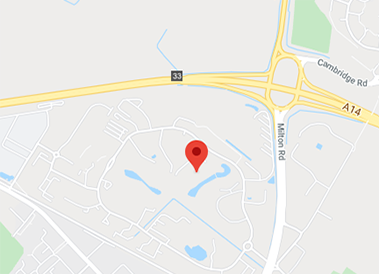Quantum light sources are a technology for optical emission with control down to the level of single photons, or light particles. With this advanced technology, a wide range of applications can be possible, from long-distance Quantum Key Distribution through optical fibre networks to logic operations at the nanoscale on a semiconductor chip.
Our mission is to develop novel structures for the generation of quantum light, and for future integration into quantum communication systems. We demonstrated the world’s first device able to electrically generate and transmit a stream of single photons from a semiconductor chip. The key to generation of single photons on a chip is the use of semiconductor quantum dots, with dimensions of a few nanometres. The small size of quantum dots allows only a few electrons to be contained within, and consequently only a few photons to be emitted. By controlling the excitation and emission process, we can ensure only a single photon is emitted each cycle.
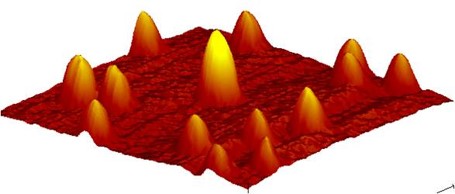
Quantum Dot Technology
Our quantum light sources are based on familiar opto-electronic components known and light emitting diodes (LEDs). However, at their core they contain a tiny cluster of semiconductor atoms, known as a quantum dot. Quantum dots can only hold enough electrical charge to emit a few photons, and only one with a particular wavelength, or colour.
Quantum dots are grown by conventional semiconductor foundry systems using specialised techniques. One method utilises a natural growth progression where one material is grown on the top of another to create strain due to different natural spacing of the atoms in the different materials. Strain relaxation wrinkles the top semiconductor layer, creating nanocrystal bumps that become quantum dots. Another method relies on the formation of molten metallic droplets on the surface of a semiconductor, like water droplets on glass.
An advantage of semiconductor quantum dots is their grounding in conventional opto-electronics technology. This allows augmentation of our quantum light sources with established technology such as resonant optical cavities to improve efficiencies, and electrical contacting to allow single photons to be generated directly by switching a voltage.
Entanglement
Entangled photons are another important class of quantum light state, required for more advanced applications in quantum communication and computing. Entangled photons have interconnected properties, so that measurement of one changes the other, even if it is far away. Since quantum information cannot be copied, entanglement is fundamental to many protocols that require information to be transferred between qubits. At Toshiba, we are developing sources of entangled photons. The photons are entangled in their polarisation, which is the orientation of the electromagnetic field. Measurement of the polarisation of a photon gives a random result, that will cause the paired photon to have the same polarisation.
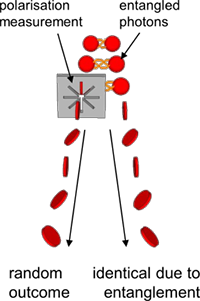
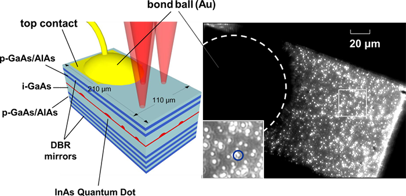
Entangled LED
Generation of entangled light can be achieved in several ways, but at Toshiba we focus on technology compatible with conventional semiconductor opto-electronics. We introduced the world’s first entangled light emitting diode (ELED), which generates pairs of entangled photons in a semiconductor device similar the humble LEDs found in low energy lighting and in consumer electronics.
The device is based on tiny nano-metre scale quantum dots made from the semiconductor indium arsenide (InAs), within a resonant cavity LED. Applying an electrical current causes charge to accumulate within the quantum dots, which then emit pairs of entangled photons. In the image, each of the bright spots corresponds to such a quantum dot, and light from just one of which is collected using a microscope lens for applications. Our LEDs can operate at high frequencies and with telecom compatible wavelength.
Quantum Interference
The interference of two photons on a beam splitter lies in the heart of most protocols for quantum logic operations using linear optics. For successful operation, the interfering photons need to be “indistinguishable” in the frequency, polarisation and bandwidth degrees of freedom. Photons generated by off-resonant excitation schemes in quantum dots suffer from poor coherence properties, which have a detrimental effect on photon indistinguishability. We have demonstrated the emission of highly-indistinguishable photons from a chip by using optical excitation resonant with the quantum dot transition. Under such scheme, known as Resonance Fluorescence, near perfect photon indistinguishable can be achieved that can lead to on-chip quantum logic operations with high fidelity.
Quantum Teleportation
Quantum teleportation offers a way to move quantum data around quantum networks by destroying quantum information so that it can appear elsewhere. Its name was inspired by similarities with teleportation in science fiction, but quantum teleportation doesn’t break any laws of physics.
To teleport quantum information, we need to share a pair of entangled qubits between a sender and receiver. One of the entangled qubits is destroyed, together with the input qubit, which teleports the input data onto the receivers remaining qubit.
The destruction of the qubits reveals no information about the information encoded on the input, but does indicate if any adjustment to the output qubit is necessary, so teleportation is not faster than light speed.
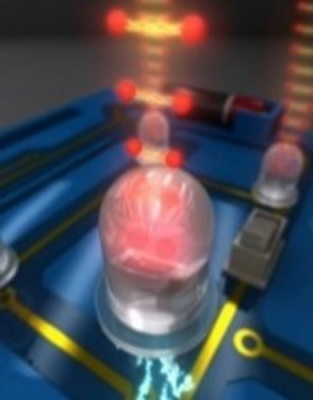
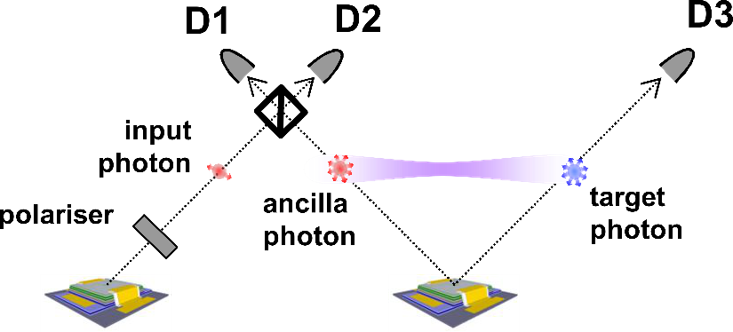
Selected publications
Electrically Driven Single-Photon Source, Z. L. Yuan et al., Science, 2002.
An entangled-light-emitting diode, C. L. Salter et al., Nature, 2010.
Active reset of a radiative cascade for entangled-photon generation beyond the continuous-driving limit, J. R. A. Müller et al., Phys. Rev. Research 2, 2020.
1GHz clocked distribution of electrically generated entangled photon pairs, G. Shooter et al., Opt. Express, 2020.
Quantum teleportation using highly coherent emission from telecom C-band quantum dots, M. Anderson et al., npj Quantum Information, 2020.
Latest Publications
Davide G. Marangon, Peter R. Smith, Nathan Walk, Taofiq K. Paraïso, James F. Dynes, Victor Lovic, Mirko Sanzaro, Thomas Roger, Innocenzo De Marco, Marco Lucamarini, Zhiliang Yuan & Andrew J. Shields
J. A. Dolphin T, ENG, T. K. Paraïso T, H. Du T, R. I. Woodward T, D. G. Marangon T and A. J. Shields T





